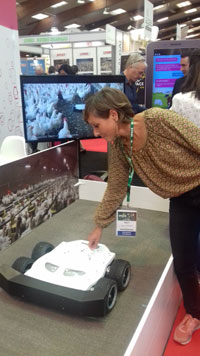



Robots Top Agenda at Annual French Livestock Show
FRANCE - SPACE is a huge French livestock show held annually each September in Rennes, Brittany. This year, it attracted a record nearly 150,000 visitors, Stuart Lumb reports.Each year the organisers highlight an area of interest to farmers and part of one of the halls is set aside for demonstrations and talks. The focus this year, courtesy of SPACE and the Brittany Chambers of Agriculture, was Robotics for Farmers.
Robots are taking over tasks from humans in several industries, and the opportunities and problems of an increasingly automated workplace is a hot topic – particularly given the challenges associated with labour supply in Europe. But what are the benefits of robots to farmers? Of course, they can work 24/7.
They don’t need tea breaks or holidays. They can work in situations that would be dangerous or even life-threatening to humans – bomb disposal, for example – where a very expensive robot is cheap in terms of its life-saving capabilities.
Many farming jobs are repetitive and boring, meaning people switch off and things don’t get done properly. Cleaning and disinfecting buildings, for example, also requires operatives to wear bulky protective clothing, which robots don’t need.
Think of power washing in the middle of winter – freezing cold, water everywhere. No wonder one of the first robots used in livestock production was a power washer developed in Sweden, a country with extremely high labour costs. As farming struggles to attract younger entrants, could replacing labour with robots be the answer?
A brave new world of data?
Modern farms produce and use a large amount of data, which is ideally suited to automating operations. Feeding equipment, for example, is highly complex and computer controlled. The same applies to environmental controllers, needed to control cooling and heating equipment.
Farmers are now trying to find ways to harness this data to improve efficiency. DomoPig is a collaborative project that won a two star award at SPACE 2016. With the French co-op system farmers are used to collaborating together.
DomoPig automatically collects data on the shed environment, which eradicates the need for the farmer to collect this data manually and frees up time to carry out other tasks. The data is monitored so it’s possible to see if there is a problem at building level and the farmer gets informed. Currently this project is still in trial mode, with nine pilot farms taking part.
Robotics can be utilised to a greater degree in the poultry industry, as the bulk of the buildings are large in area and level-floored. This means that robots can move quickly and the wheels don’t need to be too large. At SPACE, two robots were working in the demonstration area, attracting considerable interest from attendees
A wheely good solution

Tibot Technologies, based in Rennes, were awarded a three star award in 2016 for their Spoutnic robot, which forces hens to move and trains them to lay eggs in the nest boxes. Apart from improving layer efficiency, this reduces the amount of time staff need to spend in the poultry house.
"Training hens to lay their eggs in the nest boxes is crucial. With Spoutnic, I have an assistant always available with me on the farm. Thanks to the robot, I’ve cut my time walking through the hen house by half and also reduced the number of floor eggs. I am in better health, my flock too!" commented poultry breeder Edith Touchefeu, based in Luitre, France.
In the case of broilers, robots move the birds round which encourages natural activity – and, importantly, increases their weight gain.
Spoutnic technical data
Price: €7900
Size: 56cm x 63cm x 18cm
Weight: 10kg
Specifications: 4 wheel drive, 6 speeds, 8hour battery life, light and sound modes. Water, dust and ammonia resistant, is able to detect obstacles and avoid them
Automated aeration
Octopus Robots is a company located in Cholet, France. Octopus Scarifier is a robot designed to aerate poultry litter and has a monitoring function as well. This robot can recharge itself and can be operated 24/7. Thanks to its unique scarifier it can turn over and aerate all types of substrates.
It continuously maps indoor temperature, humidity , CO2, sound and light intensity and is equipped with motors and wheels designed to operate in harsh environments. Regular aeration of the litter inhibits fermentation and hence dramatically reduces the level of ammonia in sheds.
Octopus said: "Reducing ammonia levels increases average daily gain (ADG) by 10 per cent.
"Mortality is reduced as is the total bacterial load. Fewer drugs are needed plus time is saved using the robots. These collectively result in an annual estimated gain of €40,000."
Figures are based on a typical intensive French broiler unit, with a floor space of 1,200m2. A version of the robot is also available (Octopus Poultry Safe) that decontaminates buildings by dispensing liquid disinfectants and sanitizers as aerosols. It can also deliver liquid medicines/vaccines.
Octupus Scarifier technical data
Price: €35,000-50,000
Size: 1100mm x 1200mm x 75mm
Weight: 36kg (chassis) 14kg (batteries) 15kg (scarifier) 35kg (atomiser module)
Specifications: Both robots have three operating modes: autopilot, hand steering assisted and hand steered. Recharging time is three hours. Battery life four to eight hours (scarifier) or two to four hours (Poultry Safe)
SPACE 2018 will be held from 11-14 September 2018. Click here for more information.








